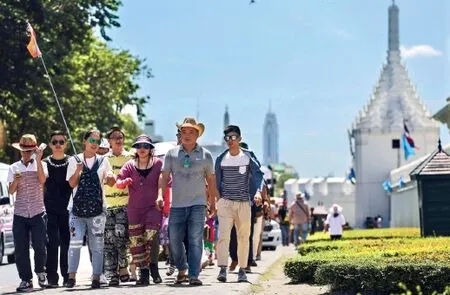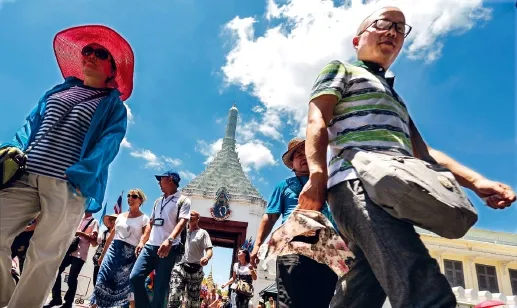Chinese Travelers Motivate ASEAN Tourism
2016-09-26ByXuZhuoping
By Xu Zhuoping
Chinese Travelers Motivate ASEAN Tourism
By Xu Zhuoping

Tourists outside the Grand Palace in Bangkok, Thailand
During this year's Chinese Spring Festival(February 7-13), a young Chinese mother,surnamed Wang, spent her holiday with her family in Thailand, rather than following tradition and spending the holiday in her hometown. So why did she choose thailand?
“Thai visa procedures are relatively simple,” Ms. Wang explains. “The costs of air travel and hotels are affordable. Most important of all, you can feel the atmosphere of the Chinese Spring Festival there.” there are many other Chinese families similar to Ms. Wang's. The number of outbound Chinese tourists amounted to 120 million in 2015, according to estimates published by the United Nations World Tourism Organization (UNWTO) in its 2015 World Tourism Barometer. this year, nearly 6 million Chinese tourists are estimated to have traveled abroad during the Chinese Spring Festival. China continues to serve as a steady source of overseas travelers for numerous popular travel destinations, particularly those in Southeast Asia. The UNWTO Barometer also indicated that since 2004,Chinese outbound travel spending has increased by double-digit percentages yearon-year, indicating remarkably strong spending power among Chinese outbound tourists.
Against the backdrop of a global economic slowdown, the continuous stream of Chinese tourists has been a crucial contributor to the growth of the global tourism market.
Strong Momentum of Growth of International Tourism
The UNWTO Barometer pointed out that the number of annual tourists visiting overseas destinations increased by 50 million in 2015. Each year since 2010, the global number of international tourists has increased at an annual rate of above 4 percent. According to the UNWTO forecast, the number of international tourists will continue to increase at a rate of 4 percent in 2016.
The continuous large-scale increase of Chinese outbound tourists has been a great boost to the tourism industries of various countries in Southeast Asia, most notablythailand. To a lesser extent, the United States and European countries are also proving to be popular destinations for Chinese tourists.
According to UNWTO statistics, the growth of international tourism in 2015 reached a new height. The overall global demand for tourism remains generally strong,with ups and downs in a small number of regions, owing mainly to fluctuations in exchange rates, the price of oil and other commodities, as well as safety and security concerns. Overall, tourism is growing quickly.
According to the Tourism authority ofthailand, during the Chinese National Day“Golden Week” of 2015 (October 1-7), the number of tourists from China's mainland to thailand exceeded 160,000, setting a new record. In 2015, Chinese tourist arrivals tothailand were the highest of any of the past eight years, according to statistics published by the Ministry of Tourism and Sports of Thailand, despite the Erawan Shrine Explosion in Bangkok in August, which killed 22 people, including four Chinese. Chinese tourists continue to view thailand as a convenient and safe tourist destination.
In total, nearly 30 million tourists visited Thailand in 2015, a year-on-year increase of more than 20 percent. Chinese tourists made up a large chunk of this increase, as Chinese arrivals alone shot up by 263 percent compared to 2011 figures, bringing the 2015 total to 8.3 million. This accounts for 36 percent of Thailand's annual inbound foreign tourists, making China the largest single country in the makeup of foreign tourists in thailand.
Tourism remains an integral part of thethai economy - accounting for around 14.5 percent of GDP - and 2015 tourism revenue of $42 billion amounted to a year-on-year increase of 23 percent.
The UNWTO pointed out that the development of tourism is dependent on the secure and convenient tourism environment of destination countries. Therefore, the organization urged the governments of all countries to incorporate tourism administration into their security planning, structure and procedures, so that the security threat to tourism is minimized, while their capability of safeguarding security and convenience of the industry is maximized.
The strong performance of tourism brought about the economic growth of many regions in the world and increased job opportunities. “the UNWTO appeals to all countries to continue with the strategy of promoting tourism, take further measures to enhance tourism convenience and develop human resources,” observed Taleb D. Rifai,Secretary General of the UNWTO.
Chinese Travelers Vital for Asia-Pacific Tourism Market
Rising income and the relaxation of visa applications have continuously increased the number of Chinese outbound travelers,most of whose first outbound destination is an Asia-Pacific country. Wu Wenxue,a Deputy Chief of the National Tourism Administration of China, indicated that in 2015, China hosted 6.55 million tourists from ASEAN countries. Among Chinese citizens, 17 million chose an ASEAN country as their first outbound destination. The number of tourists from the two sides who have exchanged visits amounted to nearly 24 million, a historical record high in terms of the scale of tourism exchanges.
A report by the Kasikorn Research Center of Thailand indicated that in recent years, Chinese tourists have begun to shape the tourism market with multi-layer purchasing power, a target market for many countries around the world, including Thailand. Although Thailand in 2015 did not initiate any incentivizing measures for Chinese tourists, such as waiving visa fees,more Chinese tourists have been encouragedto travel to Thailand by clever marketing strategies implemented by the Thai government and the private sector, as well as promotional activities in China by Chinese travel firms.

Chinese tourists in Bangkok
According to Matthew Driver,MasterCard's Executive of Global Products and Solutions for Asia-Pacific, Chinese tourists are the main source behind the increase in the number of tourists in the Asia-Pacific region. Statistics show that between 2009 and 2015, one-third of the increase in international tourists in the Asia-Pacific region was composed of tourists from China,the total number of which is more than five times that of the second place on the list,South Korea.
In January 2016, Wu Wenxue,Deputy Chief of the National Tourism Administration of China, attended the 15th Meeting of ASEAN, Chinese, Japanese and South Korean Tourism Ministers (MATM Plus three) in Manila, the Philippines. In an interview with the Chinese media, Wu said that according to most recent forecasts, 6 million Chinese citizens are set to travel abroad during this year's Spring Festival (the week of February 7-13), and 60 percent of those are planning to travel to ASEAN countries, Hong Kong, Macao or Taiwan. Southeast Asian islands are among the most popular destinations for Chinese travelers seeking tropical climates during the Spring Festival.
Wu believes that the ASEAN tourism market possesses several unique advantages.“ASEAN countries possess rich natural and human tourism resources, as well as convenient transportation infrastructure,” he explains. “their tourism reception and service capabilities have also been improving.”
China has always attached great importance to the promotion of tourism exchanges between China and ASEAN countries. Utilizing the 10+3 mechanism - a framework of cooperation among ASEAN countries along with China, Japan and South Korea - China has implemented the Plan of Action to Implement the Joint Declaration on ASEAN-China Strategic Partnership for Peace and Prosperity(2011-2015), by promoting the development of the tourism of China and ASEAN in an innovative way for common development and shared benefits.
ASEAN States' Promotion Policies
ASEAN governments have long held a positive attitude towards developing tourism, as well as toward attracting Chinese tourists. Malaysian Prime Minister Najib Razak announced on Jan 28, 2016 that in an effort to promote the arrival of Chinese tourists, Malaysia will provide visa exemption to visiting Chinese tourists who meet certain conditions in the period from March 1 to Dec 31, 2016.
Ahmad Zahid Hamidi, Malaysian Deputy Prime Minister, has spoken in recent months of his government's desire to attract more Chinese tourists to Malaysia. Zahid hopes to reach an annual influx of 8 million Chinese tourists within the next five years. If this target is achieved, the Malaysian government estimates that tourism revenues will see a boost of 22.1 billion ringgit($5.31 billion). According to Zahid, Chinese tourists traveling to Malaysia currently total around 1.3 million. the Malaysian government's plan is an ambitious one, and will require careful planning and clever marketing to increase the influx to an annual figure of 8 million. But with a per-capita spending of 3,345 ringgit ($805) per trip, Chinese tourists are among Malaysia's most sought ather potential visitors.
The makeup of Chinese outbound tourists is changing rapidly, as an increasing number choose to travel independently rather than in tour groups - which have been the traditional mode of travel for Chinese outbound tourists in the past few decades. Destinations like Malaysia are among the most attractive to independent travelers because of policies of visa exemption -Chinese tourists simply need to arrange airline tickets.
Indonesia, too, is targeting tourism as an industry that can be boosted by clever marketing and an easing of visa restrictions. Last year, the Indonesian government introduced visa exemption policies to several countries,including China, while also investing in infrastructure and travel-related services. there has even been a push for the introduction of Chinese tourist-geared tourist packages,including a “Zheng He Maritime Road”tour package, commemorating the travels of famed Chinese Admiral Zheng He's expedition to Indonesia nearly 600 years ago.
Mr. I Gde Pitana, Indonesian Deputy Minister for International Tourism Marketing Development, is behind much of Indonesia's efforts to boost the influx of Chinese tourists.
“In order to attract Chinese tourists during the Spring Festival, our Ministry of Tourism started planning various Chinese Spring Festival celebrations as early as last December,” Pitana said. “We've cooperated with quite a few [Indonesia-based] Chinese travel services to promote these Spring Festival packages.”
During the Spring Festival of 2016, an estimated 20,000 Chinese tourists chartered flights to Indonesia to celebrate the Chinese lunar New Year.
